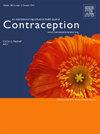中西部后多布斯诉杰克逊妇女健康组织政策背景下堕胎的障碍和促进因素
IF 2.3
2区 医学
Q1 OBSTETRICS & GYNECOLOGY
引用次数: 0
摘要
目的国家政策决定寻求堕胎者是否以及如何获得堕胎服务。我们研究了在有堕胎禁令的州和没有堕胎禁令的州考虑堕胎的人在堕胎护理方面的障碍和促进因素是如何不同的。方法从2023年7月至2025年5月,我们通过b谷歌广告、堕胎信息和堕胎基金网站,在美国中西部12个州招募有堕胎意向的孕妇。我们比较了生活在完全禁止堕胎或怀孕超过6周的州的参与者(禁止州参与者,n=151)和生活在没有这些禁令的州的参与者(非禁止州参与者,n=216)之间报告的堕胎障碍和促进因素。结果在367份回复中,禁令州的人比非禁令州的人报告了更多的障碍(平均3.0比2.3),更少的护理促进者(0.9比1.2)。最常见的是,参与者报告需要钱来支付堕胎和获得这种护理的后勤费用(67.6%),禁令州的更多的人报告了这一障碍(78.5%对63.3%)。禁制国比非禁制国更多的参与者报告面临后勤障碍(42.3%对24.6%),担心自己或他人面临法律风险(33.6%对13.0%)。当被问及促进因素时,不同政策背景的参与者最普遍地报告说没有什么对他们有帮助(40.1%),参与者报告的促进因素在不同的政策背景下并没有很大的差异。尽管跨州寻求堕胎的人面临着护理障碍,但在禁止堕胎州的人比在非禁止堕胎州的人报告了更多的经济、后勤和法律障碍。本文章由计算机程序翻译,如有差异,请以英文原文为准。
BARRIERS AND FACILITATORS TO ABORTION BY POLICY CONTEXT IN THE MIDWEST POST-DOBBS V JACKSON WOMEN’S HEALTH ORGANIZATION
Objectives
State policies shape whether and how abortion seekers can access abortion. We examined how barriers and facilitators to abortion care differed for people considering abortion in states with abortion bans vs. in states without bans.
Methods
From July 2023 to May 2025, we recruited pregnant people considering abortion living in the 12 Midwestern states through Google Ads, and abortion information and abortion fund websites. We compared reported barriers and facilitators to abortion between participants living in states that banned abortion completely or beyond 6 weeks’ gestation (ban state participants, n=151) and those living in states without these bans (non-ban state participants, n=216).
Results
Among 367 responses, those in ban states reported more barriers than those in non-ban states (average 3.0 vs. 2.3) and fewer facilitators to care (0.9 vs. 1.2). Most commonly, participants reported needing money to pay for the abortion and the logistics to access this care (67.6%), with more people in ban states reporting this barrier (78.5% vs. 63.3%). More participants in ban states than in non-ban states reported facing logistical barriers (42.3% vs. 24.6%) and fearing legal risk to themselves or others (33.6% vs. 13.0%). When asked about facilitators, participants across policy contexts most commonly reported that nothing had helped them (40.1%), and the facilitators that participants reported did not differ greatly by policy context.
Conclusions
While people seeking abortion across state contexts faced barriers to care, those in ban states reported more financial, logistical, and legal barriers than those in non-ban states.
求助全文
通过发布文献求助,成功后即可免费获取论文全文。
去求助
来源期刊

Contraception
医学-妇产科学
CiteScore
4.70
自引率
17.20%
发文量
211
审稿时长
69 days
期刊介绍:
Contraception has an open access mirror journal Contraception: X, sharing the same aims and scope, editorial team, submission system and rigorous peer review.
The journal Contraception wishes to advance reproductive health through the rapid publication of the best and most interesting new scholarship regarding contraception and related fields such as abortion. The journal welcomes manuscripts from investigators working in the laboratory, clinical and social sciences, as well as public health and health professions education.
 求助内容:
求助内容: 应助结果提醒方式:
应助结果提醒方式:


